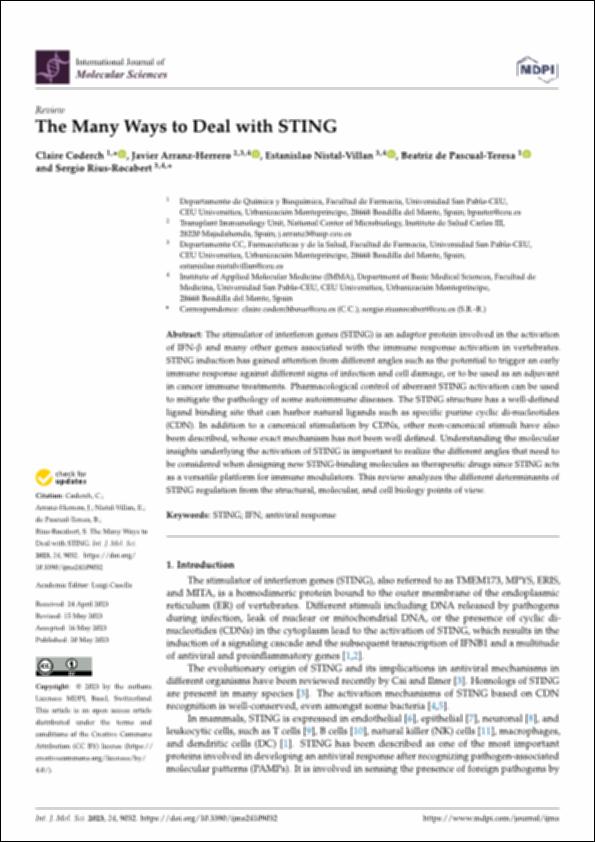Please use this identifier to cite or link to this item:
http://hdl.handle.net/10637/15530The Many Ways to Deal with STING
| Title: | The Many Ways to Deal with STING |
| Authors : | Coderch Boué, Claire Arranz Herrero, Javier Nistal Villán, Estanislao Pascual-Teresa Fernández, Beatriz de Rius Rocabert, Sergio |
| Keywords: | STING; IFN; Antiviral response |
| Publisher: | MDPI |
| Citation: | Coderch, C.; Arranz-Herrero, J.; Nistal-Villan, E.; de Pascual-Teresa, B.; Rius-Rocabert, S. The Many Ways to Deal with STING. Int. J. Mol. Sci. 2023, 24, 9032. https://doi.org/10.3390/ijms24109032 |
| Abstract: | The stimulator of interferon genes (STING) is an adaptor protein involved in the activation of IFN- and many other genes associated with the immune response activation in vertebrates. STING induction has gained attention from different angles such as the potential to trigger an early immune response against different signs of infection and cell damage, or to be used as an adjuvant in cancer immune treatments. Pharmacological control of aberrant STING activation can be used to mitigate the pathology of some autoimmune diseases. The STING structure has a well-defined ligand binding site that can harbor natural ligands such as specific purine cyclic di-nucleotides (CDN). In addition to a canonical stimulation by CDNs, other non-canonical stimuli have also been described, whose exact mechanism has not been well defined. Understanding the molecular insights underlying the activation of STING is important to realize the different angles that need to be considered when designing new STING-binding molecules as therapeutic drugs since STING acts as a versatile platform for immune modulators. This review analyzes the different determinants of STING regulation from the structural, molecular, and cell biology points of view. |
| URI: | http://hdl.handle.net/10637/15530 |
| Rights : | http://creativecommons.org/licenses/by-nc-nd/4.0/deed.es Open Access |
| ISSN: | 1422-0067 |
| Issue Date: | 20-May-2023 |
| Center : | Universidad San Pablo-CEU |
| Appears in Collections: | Facultad de Farmacia |
Items in DSpace are protected by copyright, with all rights reserved, unless otherwise indicated.


